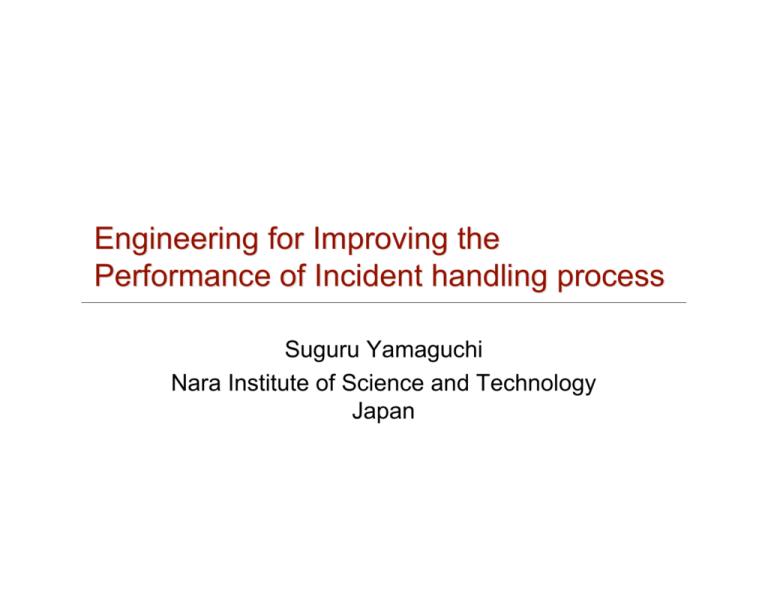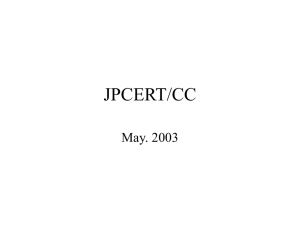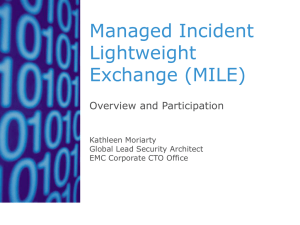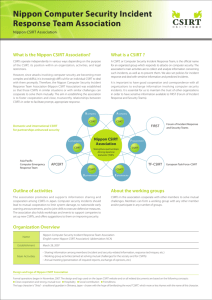Engineering for Improving the Performance of Incident handling
advertisement

Engineering for Improving the Performance of Incident handling process Suguru Yamaguchi Nara Institute of Science and Technology Japan Overview Incident Handling by CSIRT IODEF and its development & deployment – IODEF was originally developed as classic inter-CSIRT information exchanges. – Variety of information exchanged among CSIRT has been drastically changed:incident report, information about vulnerabilities in products, forecasts and analysis report, direct exchange of machine generated information, …. – Now phase II. Our efforts – NAIST & JPCERT/CC in Japan • Supported by research grant from MEXT/JST (FY2002 - FY2004) – Working with US-CERT/CERTCC (US) and NISCC (UK) – Working with APCERT teams – IETF INCH WG Overview of Incident Handling by CSIRT CSIRT: Computer Security Incident Response Team – CERT/CC, US-CERT, JPCERT/CC, Telecom-ISAC, NIRT, NISCC, … Functions – Provide response to incidents for its constituency – Provide warnings and alerts for its customers – Act as information clearing house, especially on information about vulnerabilities in commercial products – Act as information exchange among CSIRTS – Move from “response” to “preparation” and “prevention” CSIRT: Coordination Victims CSIRT Technical analysis, guidance, … working together Involved site Involved site Vendors, ISP, SIers CSIRT: warnings & alerts info info info Analysis Forecasting Technical source for fixing security holes – Vendor notes – CERT/CC advisory – …. Warnings & Alerts – Quick fix on systems in its constituency Issues Too many forms of communication – – – – Reports from victims (e-mail) Reports from vendors (e-mail) Reports from other CSIRT’s (e-mail) Automatic generated reports from IDS/IDP boxes. (SNMP, but normally private MIB, not colorful) Acceleration required, but how? – Semi-automatic information exchange among CSIRT – Automatic information exchange, (challenge!) – Human readable form → machine readable form Efforts, so far IETF INCH WG – INCident Handling WG – Define “IODEF” format, XML based, for information exchange among CSIRTs – Since 2002 Efforts – Initial version of IODEF, described in XML, by CERT/CC • “The Incident Object Description Exchange Format (IODEF) Implementation Guide,” draft-ietf-inch-implement-00.txt – Language extension, mainly by NAIST & JPCERT/CC – Extensions for real time, inter-network defense, (RID), by MIT group • Inter-AS data exchange • Traceback for DDoS Activity for IODEF in our group Efforts on standardization in IETF INCH WG. Tools developed for incident response handling procedures in CSIRT, using IODEF Development of framework for APCERT (Asian Pacific CERT), as its deployment process Standardization Activity IODEF: huge and complex description in XML – Exchange “incident report” among CSIRT’s – Still improved in progress i18n (Internationalization) and l10n(Localization) Some improvements – Simplification of “EventData” element tree which is responsible for representing actual incident events – Specification for treatment of “RecordData” and “AdditionalData” for automatic handling IODEF documents Standardization of VEDEF New steps taken. NISCC proposed VEDEF (Vulnerability and Exploit Description and Exchange Format) at INCH WG in previous IETF60 (June 2004) JPCERT/CC had developed similar format called VulDEF, based on IODEF CERT/CC, JPCERT/CC and NICSS are collaborating for vulnerability handling Tools Development by our group IODEF Verifier Tool to create IODEF documents – Beta stage Web System for receiving “Incident Reports” in IODEF format – Beta stage ISDAS (Internet Scan Data Acquisition System) traffic data sending system – RC stage, in operation @ JPCERT/CC DBMS for ISDAS traffic data – Alpha stage IODEF Verifier To verify XML format – the validity of syntax along IODEF XML Schema (or DTD) To verify the semantic validity of the following – – – – Time and date format Timezone format as an UTC time zone format IncidentID ( provides a function but blank for now) Omit following verification • Filename,e-mail address,URL,Postal code,TEL,FAX To set and extract items (elements and attributes) from and to IODEF documents ISDAS Traffic data analysis system – Mainly scan activities, from multiple distributedinstalled sensors – More sophisticated data analysis we are aiming. – Data exchanged among CSIRT’s internationally. • Using IODEF. Handling tools for ISDAS Data ISDAS is Scan Monitoring System in JPCERT/CC – http://www.jpcert.or.jp/isdas/ JPCERT/CC sends ISDAS data in IODEF form every hour corresponding each AP countries DBMS for ISDAS traffic data (Prototype) – With Cyber Solutions Inc. – Distributed IDS network developer/provider – Joint research activities. APCERT Asia Pacific Computer Emergency Response Teams – Regional forum of CSIRT in AP – 1st AGM was held on Feb. 25th 2003 in APSIRC2003 • AusCERT (steering committee chair) • SC: AusCERT, JPCERT/CC, HKCERT, SingCERT, MyCERT, CERTCC-KR, CNCERT/CC • Secretariat: JPCERT/CC and CERTCC-KR • APSIRC (AP Security Incident Response Conference) is our annual conference. APCERT funding members CNCERT/CC CCERT HKCERT/CC ThaiCERT MyCERT CERTCC-KR JPCERT/CC, IPA/ISEC TWCERT/CC, TWCIRC (Vietnam) SingCERT ID-CERT AusCERT APCERT Cooperation Framework Making common profile (IODEF subset) in APCERT for exchanging incident data and traffic data among CSIRTs in Asia-Pacific Area – In progress CNCERT (China), JPCERT/CC (Japan) and KRCERT (South Korea) are currently discussing for developing framework – Aiming direct exchange of machine generated data from sensors. Distribution of tools for handling IODEF documents to CSIRTs, mainly for APCERT teams – Mainly EFT purposes. – I18N are highly required for Asian countries. Profile for exchanging Traffic Data among APCERT Reporter Name Å@ Organization Å@ Tel Å@ E-mail Å@ Fax °° country Å@ local area Å@ time Å@ Timezone Destination IP Å@ Port °° country °° local area Å@ time °° timezone Source IP Å@ port Å@ Protocol Å@ attack type °° country etc purpose Å@ restriction Å@ ID Å@ description Å@ contact role Future Development in our group Automatic Sending and Receiving Scan Incident Data with other CSIRTs in APCERT To the actual field…. – Apply to traditional IRH – Integration our system into “Web Form” – R&D for developing DBMS for general Incident Reports RID: Real-time Inter-network Defense Information exchange among AS, mainly for traceback purpose. – Traceback of DoS traffic, with spoofed IP source address – Inter-AS information exchange required – “in time” manner is highly required. • Automatic response. MIT group are working on this issue, so far. – RID – Various opinions and visions, still in discussion… Summary: more engineering required Still human resource is not enough in this area. – Computer Security, Network Security, Incident response, … Internet and computer networks have turned to be a dependable infrastructure – We need more reality on security management – In every phase of cyber security components – CSIRT is one of vital components More performance, more cost-effective ways in CSIRT – IODEF is one of the good example. – More engineering needed.










